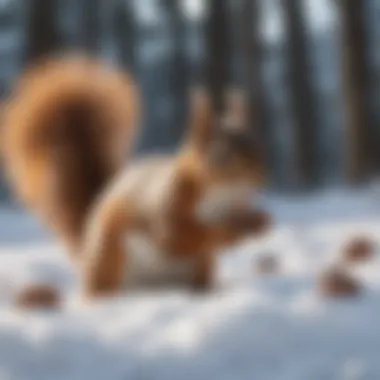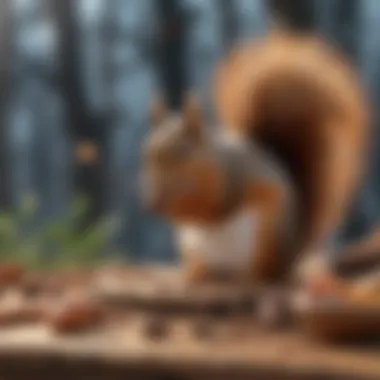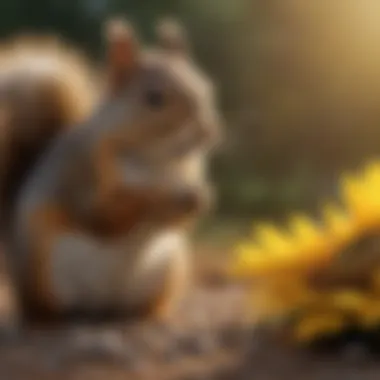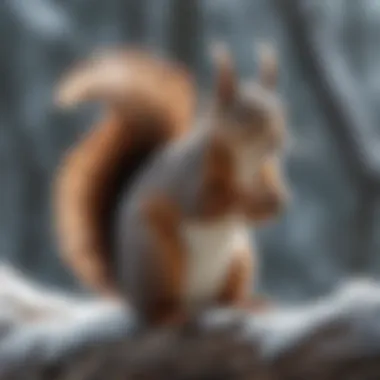Essential Winter Nutrition for Squirrels


Intro
As winter blankets the landscape with cold, squirrels face significant challenges to their survival. These agile rodents rely on their instinctive behaviors and natural foraging skills to navigate through the harsh conditions. Understanding what to feed squirrels during these months becomes crucial for wildlife enthusiasts and pet owners who wish to provide support.
This article serves as a comprehensive guide to the nutritional needs of squirrels in winter, examining suitable food sources and their feeding behaviors. By learning about these small mammals, one can adopt best practices for offering sustenance that will sustain them through the winter's chill.
Animal Species Profile
Intro to the animal species
Squirrels belong to the family Sciuridae, which includes tree squirrels, ground squirrels, chipmunks, and flying squirrels. The most commonly recognized types are Eastern gray squirrels and Fox squirrels. They are known for their distinctive bushy tails and keen ability to adapt to various environments.
Physical characteristics and appearance
Eastern gray squirrels, for example, typically measure between 16 to 20 inches in length, including the tail. Their fur ranges from gray to reddish-brown, with lighter underbelly. The Fox squirrel is larger, with a bushier tail and a reddish hue, making it quite distinct from its gray counterpart. These physical traits not only serve aesthetic purposes but also play important roles in their survival, such as insulation against cold and agility in climbing.
Natural habitat and distribution
Squirrels are incredibly versatile and can be found in diverse habitats, including urban parks, forests, and suburban areas. Eastern gray squirrels thrive in deciduous and mixed forests while Fox squirrels favor oak and pine forests. Their adaptability is crucial during winter, as they search for food and shelter in varied environments.
Behavior and social interactions
During winter, squirrels exhibit behaviors unique to the season. They often gather and store food, creating a cache that helps them during food-scarce months. Communication among squirrels includes vocalizations, tail movements, and body language to convey warnings and signals to one another. Understanding these social dynamics provides insight into their instincts and survival tactics.
Nutritional Needs in Winter
Squirrels require a balanced diet to thrive. In winter, their diet mainly consists of nuts, seeds, fruits, and sometimes fungi. Already hoarded food is utilized when fresh sources are scarce.
- Nuts: Acorns, walnuts, and hazelnuts are excellent sources of fat and energy, critical for maintaining body heat.
- Seeds: Birdseed mix or sunflower seeds can supplement their diet when nuts are in short supply.
- Fruits: Apples, berries, or dried fruits can provide essential vitamins, particularly in colder months.
- Fungi: Squirrels are known to forage for mushrooms and other fungi, which also play a role in their winter diet.
It’s essential that human intervention does not disrupt their natural feeding habits. Potentially dangerous items, such as bread or processed foods, should not be offered, as they do not provide the necessary nutrition.
Best Practices for Providing Food
Responsible feeding practices can help ensure that squirrels remain healthy in winter. Here are some tips:
- Feed in moderation: Only offer small amounts to encourage natural foraging.
- Use appropriate feeders: This can help protect the food from other animals.
- Avoid artificial foods: Stick to natural foods like nuts and seeds.
- Monitor feeding habits: Observe their behavior to adjust feeding accordingly.
Providing squirrels with the right food sources during winter not only supports their health but also contributes positively to local wildlife.
By understanding the dietary requirements and habits of squirrels, one can play a significant role in supporting their survival during the challenging winter months.
Understanding Squirrel Physiology
Understanding squirrel physiology is essential for anyone interested in supporting these animals, particularly during the winter months. Squirrels possess unique biological characteristics that dictate how they survive in harsh weather and seek food. An appreciation for their physiological requirements helps in making informed decisions about their care and feeding during winter, ensuring these creatures can thrive despite the seasonal challenges they face.
Basic Biological Needs
Energy Requirements
Squirrels have specific energy needs that change with the seasons. During winter, their energy requirements can increase significantly due to colder temperatures and reduced food availability. This increase in energy demand arises from the need to maintain body heat and perform essential daily activities, such as foraging and nesting. The key characteristic of these energy requirements is that they are closely tied to their metabolic rate, which in turn is influenced by temperature.
Feeding squirrels high-energy foods can be beneficial, especially during this time. Foods rich in fats, like certain nuts, provide the calories they need to survive winter. One unique feature related to this aspect is that squirrels often engage in selective foraging, opting for foods that offer the highest caloric return. This can pose an advantage for those who want to assist them. However, overdependence on one type of food can also lead to nutritional imbalances.


Metabolic Adaptations
The metabolic adaptations of squirrels are incredibly fascinating. They have evolved to adjust their metabolism based on food availability and seasonal changes. These adaptations allow them to effectively store energy in the form of fat during the autumn months, which they then utilize in winter. The key characteristic of this metabolic flexibility is its role in energy conservation, effectively allowing squirrels to withstand periods of food scarcity.
In winter, when food is less easily accessible, this adaptability becomes crucial. It is a beneficial trait since it enables them to survive longer without frequent feeding. While these adaptations are advantageous, there are also disadvantages. If squirrels cannot locate their stored food or if the food becomes spoiled or lost, their survival can be jeopardized, leading to malnutrition.
Behavioral Patterns in Winter
Food Storage Behaviors
Food storage behaviors are vital to squirrel survival in winter. Squirrels are known for caching food, a practice where they bury nuts and seeds to find them later. This behavior not only provides a winter food source but also plays a role in forest regeneration as some buried seeds may sprout into new plants. The key characteristic of these behaviors is the instinctual nature of caching. Squirrels utilize memory and spatial cues to recover their storages.
The ability to store and retrieve food enhances their chances of surviving through the frigid months. This act of caching is a beneficial strategy for maintaining an adequate food supply when natural sources are scarce. However, it can also present disadvantages. Loss of cached food due to competitors or poor memory can reduce the amount of food they have in winter.
Hibernation vs. Torpor
Understanding the difference between hibernation and torpor is essential for grasping how squirrels cope with winter. Squirrels do not hibernate in the traditional sense. Instead, they enter states of torpor, where they significantly lower their metabolic rate and body temperature for short periods, allowing them to conserve energy. The key characteristic of torpor is its temporary nature, which contrasts with true hibernation, where animals remain inactive for extended periods.
This behavioral adaptation provides a strategic advantage as squirrels can still remain active and forage when circumstances permit. This behavior is particularly relevant for this article, as it underlines the need for available food sources during the irregular feeding times of torpor. However, the disadvantage is that during very cold snaps, prolonged periods of inactivity may leave them vulnerable if food sources are not readily accessible.
Seasonal Feeding Habits
Understanding the seasonal feeding habits of squirrels is crucial for anyone looking to support these animals during the colder months. In winter, squirrels face significant challenges as food becomes less abundant. Adjusting their diet according to the seasonal availability of food sources is vital for their survival. Recognizing these changes can aid wildlife enthusiasts and pet owners in providing the most suitable food to support squirrel health.
Dietary Changes in Winter
Seasonal Food Availability
During winter, the availability of fresh food substantially decreases. Squirrels rely on stored food from warmer months or turn to what is naturally available. Most trees shed their leaves, limiting access to fruits and vegetables. On the other hand, nuts and seeds remain intact, making them easily accessible. A key characteristic of seasonal food availability is its direct impact on squirrel health and behavior.
- Benefits of seasonal food availability include a more stable food supply that aligns with the squirrels' natural foraging behaviors.
- The unique feature here is that nuts and seeds often have a higher energy content, which is critical for maintaining heat and energy during cold winters. While buying nuts for squirrels may seem straightforward, ensuring they are organic and untreated is important to avoid additives that could harm the animals.
Shift in Nutritional Needs
The shift in nutritional needs during winter is significant due to the drop in temperatures and the scarcity of food. Squirrels need to change their diet to maintain their energy levels and body temperature effectively. As a result, they require more calorically dense foods. A key characteristic of this nutritional shift is an increased need for fats and proteins.
- Foods high in fats and calories, such as walnuts and hazelnuts, become essential.
- The unique aspect of this shift is that squirrels may develop habits for specific food sources that meet these changing needs. While providing high-fat foods is beneficial, moderation is key. Overfeeding squirrels can lead to obesity and health issues in the long term.
Natural Food Sources
Nuts and Seeds
Nuts and seeds comprise a primary food source for squirrels in winter. The key characteristic of this food group is its high energy density, which is essential for enduring cold winter days. Nuts such as acorns, hazelnuts, and walnuts not only provide necessary fats but are also a popular choice.
- The main advantage of nuts is their long shelf life, allowing squirrels to store them for later use.
- However, not all nuts are suitable for squirrels; some commercial varieties may contain additives that could pose health risks. Careful selection is crucial for ensuring the health of local squirrels.
Bark and Twigs
During extreme conditions, when food sources are scarce, squirrels may consume bark and twigs. Bark provides essential nutrients and fibers, while twigs can offer a source of roughage important for digestion. The key characteristic here is resourcefulness in food sourcing.
- This adaptability helps squirrels manage their dietary needs when other food sources are not readily available.
- While bark and twigs may not have the same nutritional value as nuts, their ability to provide sustenance in dire situations is impressive. However, not all tree species are suitable; some could be toxic, hence it's critical to identify safe options.
Providing appropriate foods throughout winter can help maintain healthy squirrel populations.
Safe Foods for Winter Feeding


In the cold months, providing safe foods for squirrels becomes essential. Squirrels, like many animals, require a balanced diet to thrive. Winter can be challenging for them due to reduced natural food sources. By understanding what constitutes safe food, we can help sustain the squirrel population and ensure their health. Selecting appropriate foods encourages foraging behavior and helps maintain the ecosystem balance. It is not enough to just provide any food; care must be taken to avoid harmful options.
Recommended Nuts
Walnuts
Walnuts are a popular choice for winter feeding. They provide high amounts of fat and energy, ideal for squirrels during the cold months. One key characteristic of walnuts is their rich omega-3 fatty acids, which support cardiovascular health. This makes walnuts a beneficial choice in cold weather. The hard shell also offers mental stimulation as squirrels work to access the nut inside. However, care must be taken to offer them unprocessed and unsalted variates.
Almonds
Almonds are another recommended nut for squirrels. They are nutrient-dense, providing protein and healthy fats. The unique feature of almonds is their versatility; they can be offered raw or roasted, though raw is preferable. Almonds are popular because they are easy for squirrels to consume. However, it's important to avoid salted or flavored almonds, which could be harmful to them.
Fruits and Vegetables
Apples
Apples are a good source of vitamins for squirrels in winter. They are hydrating and can be helpful in maintaining squirrels’ health. A key characteristic of apples is their fiber content, which assists in digestion. They are considered a popular choice as they are generally well-accepted by squirrels. However, it's important to slice them and remove the seeds to prevent any choking hazards.
Carrots
Carrots offer another beneficial option for feeding squirrels. They are crunchy, which helps squirrels keep their teeth trimmed. The high beta-carotene content can boost their immune system. Carrots are easy to find and can be given raw. However, they should be provided in moderation as they are high in sugar.
Commercial Squirrel Food
Pros and Cons
Commercial squirrel food is an option for feeding, which has both advantages and disadvantages. One key characteristic is convenience; it often contains an optimal mix of nutrients. However, some brands do not offer high-quality ingredients or additives that could be harmful. Reading labels is essential to ensure the product is beneficial.
Choosing Quality Brands
Choosing quality brands is vital when it comes to commercial squirrel food. Opting for reputable brands ensures better nutritional value. A unique feature of these brands is that they often use more natural ingredients without fillers. Thus, taking time to research product options can lead to healthier feeding choices for squirrels.
In summary, selecting safe foods for winter feeding contributes significantly to the well-being of squirrels. Understanding their dietary needs aids in making informed decisions that support their health and longevity.
Foods to Avoid
Understanding which foods are harmful to squirrels is essential when providing support during winter. Choosing safe foods is crucial. Certain items can cause serious health issues. This section sheds light on the specific foods that should be avoided.
Toxic Foods
Chocolate
Chocolate is well-known to be toxic to many animals, including squirrels. It contains theobromine, which is effective in small doses for humans but can be very harmful to smaller creatures. The specific aspect that makes chocolate dangerous is this compound. Despite being a popular treat among people, it poses significant risks to squirrels. In this context, while chocolate may seem appealing, it should be firmly excluded from their diet. Its unique feature is the theobromine content, which can lead to symptoms such as restlessness, increased heart rate, and, in severe cases, death.
Onions
Onions are other foods that should be avoided when feeding squirrels. They contain compounds known as thiosulfates. Such substances can damage red blood cells in pets. This is critical to understand, as it directly affects their health. While onions may be common in human diets, they are not suitable for squirrels. Their ability to cause anemia in small animals makes them a danger. In this article, it is important to stress the negative impacts that onions can have, making them a poor choice.
Processed Foods
Processed foods often contain additives that are harmful to squirrels. Such items generally lack nutritional value, presenting more risks than rewards. Even if some processed foods seem safe, their hidden ingredients might harm a squirrel's health.
Salted Nuts
Salted nuts are quite popular as snacks for humans, but they should not be fed to squirrels. The high salt content can lead to dehydration and increased blood pressure in small animals. While nuts can be nutritious when unsalted, salted varieties carry risks, making them unsuitable. It’s essential to understand that what appears tasty to humans might not benefit wildlife. Their unique danger lies in how quickly squirrels might consume them, leading to health problems.


Sugary Snacks
Sugary snacks are another category that should be avoided. They may attract squirrels due to their sweetness but offer no real nutrition. These foods can lead to obesity and dental issues. It’s worth noting that squirrels do not naturally consume large amounts of sugar. Their daily needs require a diet based mainly on natural foods. The presence of sugar can also disrupt a squirrel's metabolism. Therefore, providing them with sugar-laden foods is not advisable.
Avoiding these specific foods is crucial in ensuring squirrels receive the proper nutrients they need during winter. Misguided intentions to help can lead to health problems.
Feeding Techniques
Feeding techniques are crucial when it comes to sustaining squirrels during the harsh winter months. Proper feeding strategies can determine the success of their survival through cold weather. This section focuses on essential elements such as best practices and feeding stations designed to aid squirrel nourishment effectively. Adopting the right techniques ensures that these small mammals receive balanced nutrition while minimizing risks associated with human interference.
Best Practices for Feeding
Moderation and Variety
Moderation and variety are key principles in providing food to squirrels. Offering a mixed diet helps prevent nutritional deficiencies. Each food type has unique benefits and drawbacks. For instance, nuts supply fats and proteins, while fruits offer necessary sugars. These diverse food options enhance dietary balance and mimic natural feeding behaviors.
However, overfeeding one type can lead to dependency or health issues. Therefore, it's essential to maintain a consistent yet diverse feeding regimen. Such an approach keeps squirrels healthy and active, ensuring they can gather reserves for the winter.
Environmental Considerations
Environmental considerations play a significant role in how and when to feed squirrels. Keeping feeding stations clean and free of debris minimizes the risk of disease. Additionally, using biodegradable materials for feeders promotes sustainability. The unique feature of considering the environment helps balance human interaction with wildlife. By choosing the right locations and materials, you can reduce harm while supporting squirrel populations.
Moreover, understanding local wildlife dynamics allows for better planning. The presence of natural predators or other competitors can influence feeding patterns. Striking a balance is vital for the health of both the squirrels and the ecosystem.
Feeding Stations
Designing Feeders
Designing feeders is an important aspect of establishing feeding stations. A well-constructed feeder can protect food from weather elements and pests. The design should allow easy access for squirrels, encouraging them to use the station consistently. Features like escape routes can help keep squirrels safe from predation while they eat.
The versatility of feeders is also valuable; multiple designs can cater to various squirrel species and sizes. Experimenting with designs can lead to more efficient feeding practices, ultimately leading to healthier squirrels.
Placement for Accessibility
Placement for accessibility is critical for promoting successful feeding. Feeders should be placed in locations that allow easy access for squirrels while ensuring their safety from ground predators. Heights and distances from human habitats need careful consideration; placing feeders near trees can offer squirrels the cover they need.
Accessibility not only enhances feeding but also ensures squirrels can gather food easily. Moreover, strategic placement minimizes waste and maximizes food uptake, contributing to overall squirrel health. By considering these factors, you can enhance the effectiveness of your feeding efforts, allowing for a thriving squirrel population in winter.
Monitoring Squirrel Health
Monitoring the health of squirrels during winter is essential for ensuring they receive the proper nutrition and care. Squirrels have specific dietary requirements that can change based on the availability of food sources. By paying attention to their health, we can make informed decisions about feeding practices and contribute to the overall well-being of these animals. Understanding the signs of malnutrition and how environmental factors play a role helps wildlife enthusiasts and pet owners create a supportive habitat for squirrels.
Signs of Malnutrition
Physical Symptoms
Physical symptoms are critical indicators of the overall health of squirrels. These symptoms can manifest as weight loss, dull fur, or less energy than usual. Such physical signs are beneficial to recognize as they allow for timely intervention. For example, a squirrel that appears to be losing weight may be struggling to find adequate food. Addressing these symptoms is necessary not only for the care of the individual animal but also for fostering a healthier ecosystem. Malnutrition can make squirrels more susceptible to diseases, which can have ripple effects in their population.
Behavioral Changes
Behavioral changes are another key aspect of monitoring squirrel health. When squirrels are malnourished, they may exhibit altered activities, such as reduced foraging behavior or increased aggression. Noticing these behavioral shifts can help caretakers adjust feeding strategies quickly. For instance, a squirrel that is normally active but becomes lethargic might be in need of a better food supply. Recognizing these changes is essential for fostering a sustainable feeding practice, ensuring squirrels can thrive in their environment.
Contributing to a Balanced Ecosystem
Natural Predators
Natural predators play a crucial role in maintaining a balanced ecosystem, impacting squirrel populations indirectly. While it may appear detrimental to squirrels, a healthy predator population keeps the balance among species. This dynamic ensures that the most fit squirrels survive, which contributes to the overall health and resilience of the species. Educating ourselves about the importance of these natural controls is a vital step towards holistic wildlife management.
Plant Diversity and Squirrel Feeding
Plant diversity is critical in supporting the dietary needs of squirrels. Diverse plant life ensures a consistent supply of nuts, seeds, and fruits that squirrels rely on for nutrition. When various plant species flourish, they provide better food sources for feeding. Supporting plant diversity through responsible gardening or landscaping can positively impact local squirrel populations. It is beneficial to understand that a rich ecological environment contributes to the overall health of squirrels, enhancing their feeding opportunities and the sustainability of their habitat.







